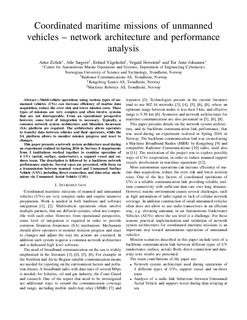| dc.contributor.author | Zolich, Artur Piotr | |
| dc.contributor.author | Johansen, Tor Arne | |
| dc.contributor.author | Sægrov, Atle | |
| dc.contributor.author | Vågsholm, Erlend | |
| dc.contributor.author | Hovstein, Vegard Evjen | |
| dc.date.accessioned | 2017-12-13T11:54:29Z | |
| dc.date.available | 2017-12-13T11:54:29Z | |
| dc.date.created | 2017-12-10T15:37:31Z | |
| dc.date.issued | 2017 | |
| dc.identifier.issn | 2160-4886 | |
| dc.identifier.uri | http://hdl.handle.net/11250/2471118 | |
| dc.description.abstract | Multi-vehicle operations using various types of unmanned vehicles (UVs) can increase efficiency of marine data acquisition, reduce the crew risk and lower mission costs. These types of missions are very complex and often involve systems that are not interoperable. From an operational perspective however, some level of integration is necessary. Typically, a common network system architecture and Situation Awareness (SA) platform are required. The architecture allows operators to transfer data between vehicles and their operators, while the SA platform allows to monitor mission progress and react to changes. This paper presents a network system architecture used during an experiment realized in Spring 2016 in Norway. 8 departments from 5 institutions worked together to combine operation of 4 UVs (aerial, surface, underwater), a support vessel and on-shore team. The description is followed by a backbone network performance analysis. Several cases are presented, with focus on a transmission between manned vessel and Unmanned Surface Vehicle (USV), including direct connection, and data-relay mechanism via Unmanned Aerial Vehicle (UAV). | nb_NO |
| dc.language.iso | eng | nb_NO |
| dc.publisher | Institute of Electrical and Electronics Engineers (IEEE) | nb_NO |
| dc.title | Coordinated maritime missions of unmanned vehicles - network architecture and performance analysis | nb_NO |
| dc.type | Journal article | nb_NO |
| dc.type | Peer reviewed | nb_NO |
| dc.description.version | acceptedVersion | nb_NO |
| dc.source.journal | IEEE International Conference on Wireless and Mobile Computing, Networking, and Communications | nb_NO |
| dc.identifier.doi | 10.1109/ICC.2017.7996481 | |
| dc.identifier.cristin | 1525329 | |
| dc.relation.project | Norges forskningsråd: 223254 | nb_NO |
| dc.relation.project | Norges forskningsråd: 269480 | nb_NO |
| dc.description.localcode | © 2017 IEEE. Personal use of this material is permitted. Permission from IEEE must be obtained for all other uses, in any current or future media, including reprinting/republishing this material for advertising or promotional purposes, creating new collective works, for resale or redistribution to servers or lists, or reuse of any copyrighted component of this work in other works. | nb_NO |
| cristin.unitcode | 194,63,25,0 | |
| cristin.unitcode | 194,63,35,0 | |
| cristin.unitname | Institutt for teknisk kybernetikk | |
| cristin.unitname | Institutt for elektroniske systemer | |
| cristin.ispublished | true | |
| cristin.fulltext | postprint | |
| cristin.qualitycode | 1 | |
